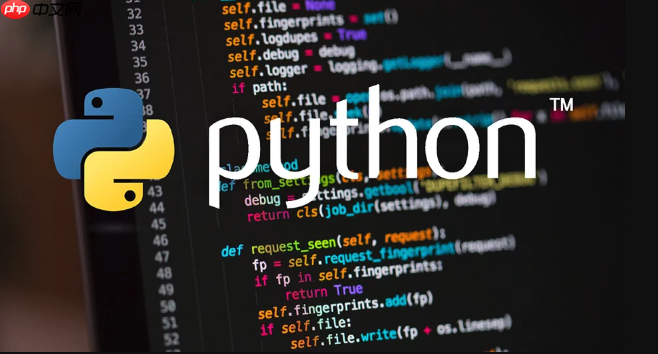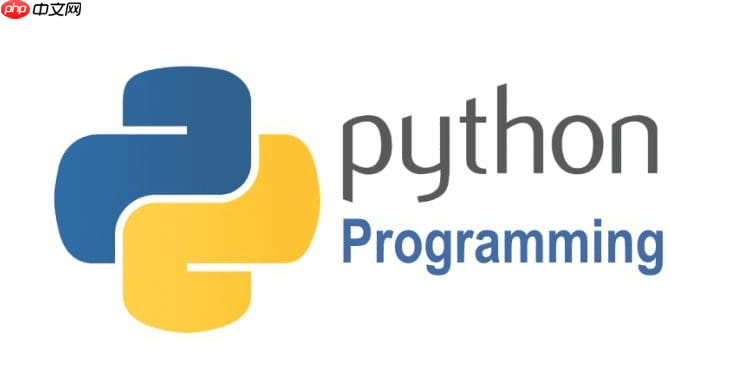python中正则表达式主要通过re模块实现,用于字符串的模式匹配与查找替换等操作。1.re.compile()可预编译正则表达式以提高效率;2.re.search()查找第一个匹配项;3.re.match()仅从字符串开头匹配;4.re.findall()返回所有匹配项列表;5.re.finditer()返回匹配迭代器;6.re.sub()用于替换匹配子串;7.re.split()按模式分割字符串。特殊字符如. ^ $ * + ?等用于定义复杂模式,分组用()捕获匹配内容,flags参数控制匹配行为(如忽略大小写、多行模式等),编写高效正则包括预编译、避免过度通配、使用非捕获分组等技巧,应用场景涵盖数据验证、提取、清洗、日志分析、代码生成及网络爬虫。

正则表达式在Python中,主要通过re模块来实现,用于进行字符串的模式匹配和查找替换等操作。简单来说,就是你给Python一个“规则”,让它帮你找符合这个规则的文本。

解决方案

Python的re模块提供了一系列函数,方便你使用正则表达式。以下是一些常用的函数及其使用方法:
立即学习“Python免费学习笔记(深入)”;
-
re.compile(pattern, flags=0): 编译正则表达式模式,返回一个正则表达式对象。预编译可以提高效率,特别是当同一个模式需要多次使用时。
import re pattern = re.compile(r'\d+') # 匹配一个或多个数字 result = pattern.findall('12 drummers drumming, 11 pipers piping, 10 lords a-leaping') print(result) # 输出: ['12', '11', '10']这里,
r'\d+'是一个原始字符串,表示一个或多个数字。re.compile()将这个模式编译成一个正则表达式对象,然后就可以用这个对象进行查找了。 -
re.search(pattern, string, flags=0): 在字符串中查找匹配正则表达式模式的第一个位置,如果找到匹配,则返回一个Match对象。否则,返回None。import re result = re.search(r'hello', 'hello world') if result: print(result.group(0)) # 输出: helloresult.group(0)返回匹配的整个字符串。 -
re.match(pattern, string, flags=0): 尝试从字符串的起始位置匹配正则表达式模式,如果匹配成功,则返回一个Match对象。否则,返回None。注意,re.match()只从字符串的开头开始匹配。import re result = re.match(r'hello', 'hello world') if result: print(result.group(0)) # 输出: hello result = re.match(r'world', 'hello world') if result: print(result.group(0)) # 这行不会执行,因为'world'不在字符串的开头 else: print("No match at the beginning") # 输出: No match at the beginning -
re.findall(pattern, string, flags=0): 在字符串中查找所有匹配正则表达式模式的非重叠字符串,并以列表的形式返回。import re result = re.findall(r'\d+', '12 drummers drumming, 11 pipers piping, 10 lords a-leaping') print(result) # 输出: ['12', '11', '10']
-
re.finditer(pattern, string, flags=0): 在字符串中查找所有匹配正则表达式模式的非重叠字符串,并以迭代器的形式返回。迭代器中的每个元素都是一个Match对象。import re result = re.finditer(r'\d+', '12 drummers drumming, 11 pipers piping, 10 lords a-leaping') for match in result: print(match.group(0)) # 依次输出: 12, 11, 10 -
re.sub(pattern, repl, string, count=0, flags=0): 在字符串中查找匹配正则表达式模式的所有子串,并将其替换为repl。count指定最多替换的次数,默认为 0,表示替换所有匹配项。import re new_string = re.sub(r'\d+', 'X', '12 drummers drumming, 11 pipers piping, 10 lords a-leaping') print(new_string) # 输出: X drummers drumming, X pipers piping, X lords a-leaping
-
re.split(pattern, string, maxsplit=0, flags=0): 根据正则表达式模式分割字符串,返回一个列表。maxsplit指定最多分割的次数,默认为 0,表示分割所有匹配项。import re result = re.split(r',\s*', '12 drummers drumming, 11 pipers piping, 10 lords a-leaping') print(result) # 输出: ['12 drummers drumming', '11 pipers piping', '10 lords a-leaping']
Python正则表达式中的特殊字符有哪些?
正则表达式之所以强大,很大程度上是因为它可以使用一些特殊字符来表示复杂的模式。这些特殊字符也被称为元字符。下面是一些常见的元字符:
-
.(点号): 匹配除了换行符以外的任意单个字符。 -
^(脱字符): 匹配字符串的开头。 -
$(美元符): 匹配字符串的结尾。 -
*(星号): 匹配前一个字符 0 次或多次。 -
+(加号): 匹配前一个字符 1 次或多次。 -
?(问号): 匹配前一个字符 0 次或 1 次。 -
{m,n}: 匹配前一个字符至少 m 次,但不超过 n 次。 -
[](字符集): 匹配方括号中的任意一个字符。例如,[abc]匹配 'a'、'b' 或 'c'。 -
[^...](否定字符集): 匹配不在方括号中的任意一个字符。例如,[^abc]匹配除了 'a'、'b' 和 'c' 以外的任意字符。 -
\(反斜杠): 用于转义特殊字符,使其失去特殊含义。例如,\.匹配点号本身,而不是任意字符。 -
|(竖线): 表示“或”,匹配竖线两侧的任意一个模式。 -
()(分组): 用于将多个字符组合成一个单元,可以对分组应用量词,也可以捕获分组匹配的文本。
如何在Python正则表达式中使用分组和捕获?
分组和捕获是正则表达式中非常强大的功能,它们允许你将模式的一部分组合在一起,并单独提取匹配的内容。
-
分组: 使用圆括号
()可以将正则表达式的一部分组合成一个分组。 -
捕获: 默认情况下,每个分组都会被捕获。你可以使用
Match对象的group()方法来访问捕获的分组。group(0)返回整个匹配的字符串,group(1)返回第一个分组匹配的字符串,group(2)返回第二个分组匹配的字符串,以此类推。
import re
pattern = re.compile(r'(\w+) (\w+)') # 匹配两个单词,并分别分组
string = 'Isaac Newton, scientist'
match = pattern.search(string)
if match:
print("Full match:", match.group(0)) # 输出: Isaac Newton
print("First name:", match.group(1)) # 输出: Isaac
print("Last name:", match.group(2)) # 输出: Newton如果你不想捕获某个分组,可以使用 (?:...)。这被称为非捕获分组。
import re
pattern = re.compile(r'(?:\w+) (\w+)') # 只捕获第二个单词
string = 'Isaac Newton, scientist'
match = pattern.search(string)
if match:
print("Full match:", match.group(0)) # 输出: Isaac Newton
print("Last name:", match.group(1)) # 输出: Newton
# print("First name:", match.group(2)) # 报错,因为只有1个捕获组Python正则表达式的flags参数有什么作用?
re 模块中的许多函数都接受一个 flags 参数,用于修改正则表达式的匹配行为。以下是一些常用的 flags:
-
re.IGNORECASE或re.I: 忽略大小写。 -
re.MULTILINE或re.M: 多行模式。在这种模式下,^和$匹配字符串的开头和结尾,以及每一行的开头和结尾。 -
re.DOTALL或re.S: 点号匹配所有字符,包括换行符。 -
re.VERBOSE或re.X: 允许在正则表达式中使用空白字符和注释,以提高可读性。
import re
# 忽略大小写
pattern = re.compile(r'hello', re.IGNORECASE)
result = pattern.search('Hello World')
if result:
print(result.group(0)) # 输出: Hello
# 多行模式
pattern = re.compile(r'^world', re.MULTILINE)
result = pattern.search('hello\nworld')
if result:
print(result.group(0)) # 输出: world
# 点号匹配所有字符
pattern = re.compile(r'hello.*world', re.DOTALL)
result = pattern.search('hello\nworld')
if result:
print(result.group(0)) # 输出: hello\nworld
# 允许使用空白字符和注释
pattern = re.compile(r"""
hello # 匹配 hello
\s+ # 匹配一个或多个空白字符
world # 匹配 world
""", re.VERBOSE)
result = pattern.search('hello world')
if result:
print(result.group(0)) # 输出: hello world如何编写高效的Python正则表达式?
编写高效的正则表达式对于处理大量文本数据至关重要。以下是一些提高正则表达式效率的技巧:
预编译正则表达式: 使用
re.compile()预编译正则表达式,特别是当同一个模式需要多次使用时。使用原始字符串: 使用原始字符串
r'...'来定义正则表达式,可以避免反斜杠转义的问题,并提高可读性。避免过度使用通配符: 尽量使用具体的字符或字符集,而不是过度依赖通配符,例如
.。使用非捕获分组: 如果不需要捕获分组,可以使用
(?:...)来避免不必要的捕获。从字符串开头匹配: 如果可能,使用
re.match()从字符串的开头开始匹配,而不是使用re.search()在整个字符串中搜索。限制回溯: 避免编写可能导致大量回溯的正则表达式。例如,避免嵌套的量词,如
(a+)*。使用字符集: 使用字符集
[...]来匹配一组字符,而不是使用多个|运算符。例如,使用[abc]匹配 'a'、'b' 或 'c',而不是使用a|b|c。利用锚点: 使用锚点
^和$来限制匹配的位置,可以提高效率。
正则表达式在实际项目中的应用场景有哪些?
正则表达式在实际项目中有着广泛的应用,以下是一些常见的场景:
数据验证: 验证用户输入的数据是否符合特定的格式,例如邮箱地址、电话号码、身份证号等。
数据提取: 从文本中提取特定的信息,例如从网页中提取标题、链接、正文等。
数据清洗: 清洗和转换文本数据,例如去除 HTML 标签、删除重复的空格、转换日期格式等。
日志分析: 分析日志文件,提取关键信息,例如错误信息、访问量、用户行为等。
代码生成: 根据模板和规则生成代码,例如根据数据库表结构生成 ORM 代码。
网络爬虫: 编写网络爬虫,抓取网页内容。
总而言之,re模块是Python处理字符串的利器。掌握它,能让你在文本处理方面事半功倍。































